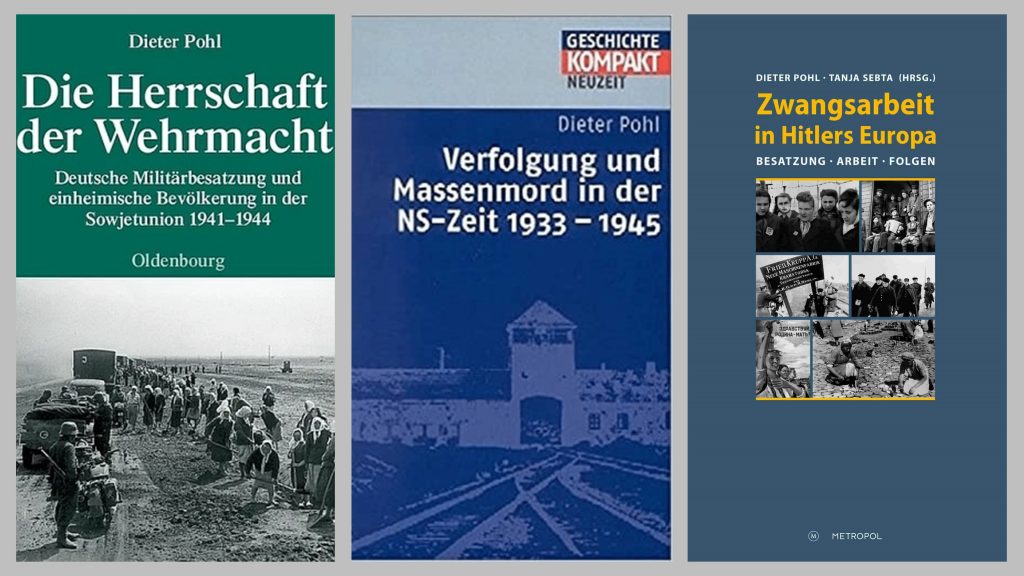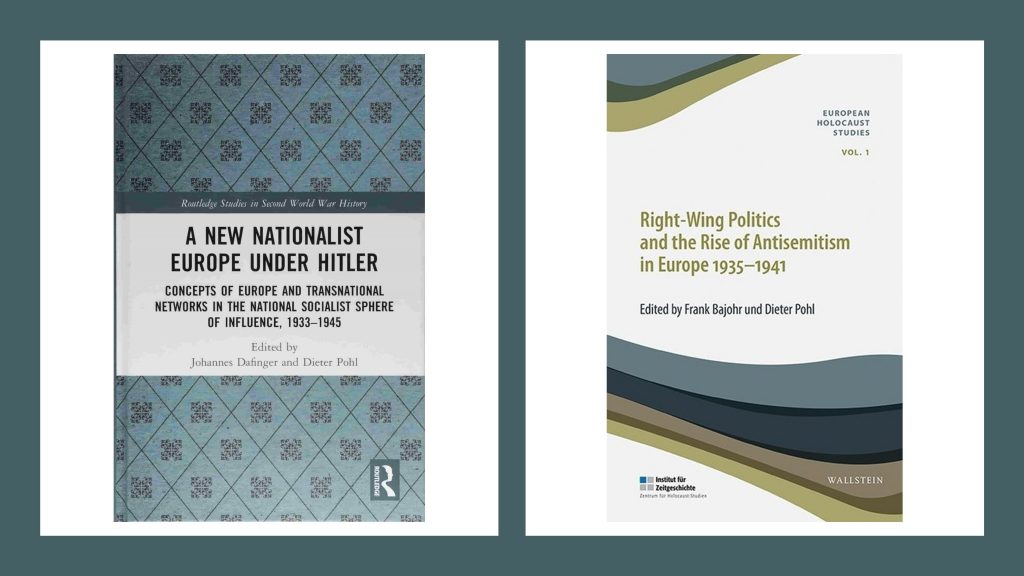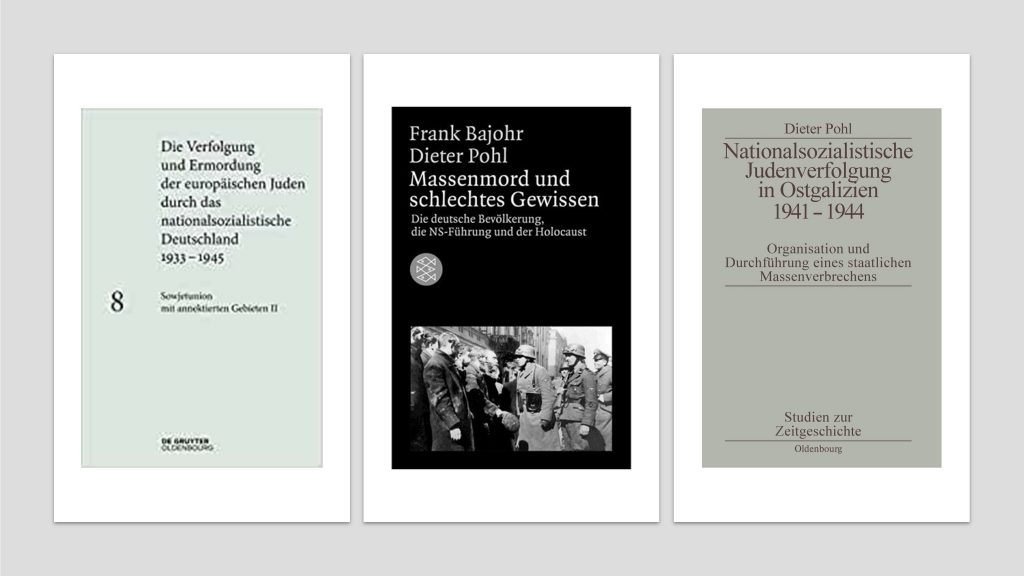Dieter Pohl: “At present, there are practically no comprehensive studies on the history of the Holocaust in the Ukrainian lands”
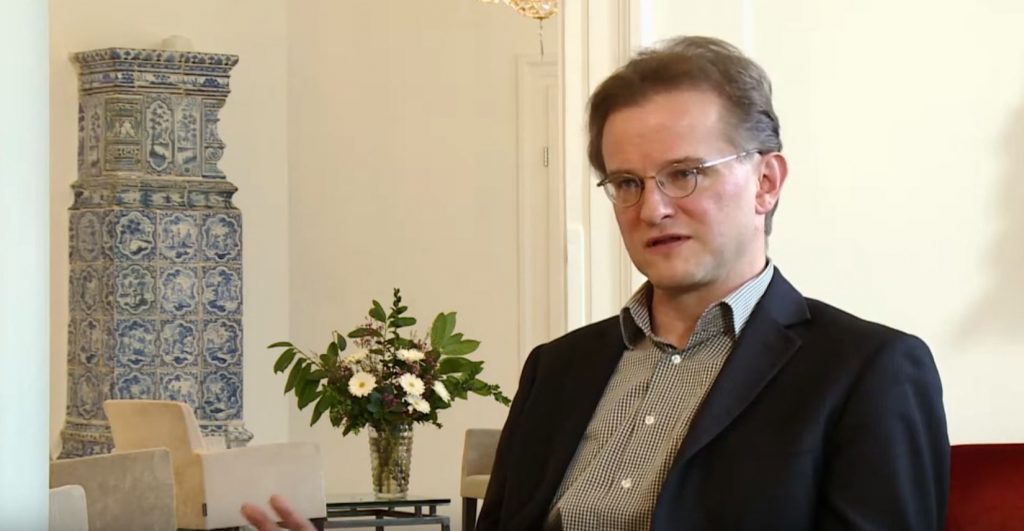
Our series of interviews with prominent historians who study genocides continues with a conversation with Dieter Pohl, professor of Contemporary History with a special emphasis on Eastern and South-Eastern Europe at the University of Klagenfurt (Austria). He is one of the most influential representatives of German and Austrian historiography of the Holocaust. We offer you an account of the formation and evolution of German historiography of the Holocaust, the characteristics of the institutionalization of Holocaust Studies in the Federal Republic of Germany and Austria, the global and local origins and contexts of the development of the Holocaust in occupied Ukraine, the role of Ukrainian nationalists and other factors in the formation of local dynamics of the Holocaust in Ukraine, etc. Professor Pohl also reflects on the competing concepts of the memorialization of Babyn Yar and the significance of current discussions about the OUN and the UPA in the democratization of political culture in Ukraine.
“I do not have a direct, personal connection to the Holocaust in terms of victims or perpetrators among my relatives”
Professor Pohl, what influenced your decision to become a historian?
I come from a family with a bourgeois past in which education was highly valued. We were interested in politics, history, culture, etc. My father owned a lot of history books, and I began reading them at an early age (somewhere around twelve or thirteen). That is when I became interested in history.
What personal factors contributed to your choice of research specialty?
I do not have a direct, personal connection to the Holocaust in terms of victims or perpetrators among my relatives. Of course, in Germany, there is public involvement in the events of the Holocaust, but this does not directly concern my family history. As well, I have no Jewish roots; I am a Catholic. A few of the books that were in our home were devoted to the Holocaust. One of them was called Der Gelbe Stern, a photography book from the 1960s. This book signaled the beginning of my interest in the history of the Holocaust. When I finished school, I decided that I wanted to study the history of the Second World War (not just the history of the Holocaust, but military history as well). A little later, I realized that the Holocaust was an event that had taken place mostly in the lands of Eastern Europe. So, I focused on the study of Eastern European history and began to learn languages. I learned Russian, Polish (comprehension and reading proficiency), and when my focus switched to Ukraine, I also learned at least how to read in Ukrainian.
Which history books were the most important to you in the process of becoming a historian?
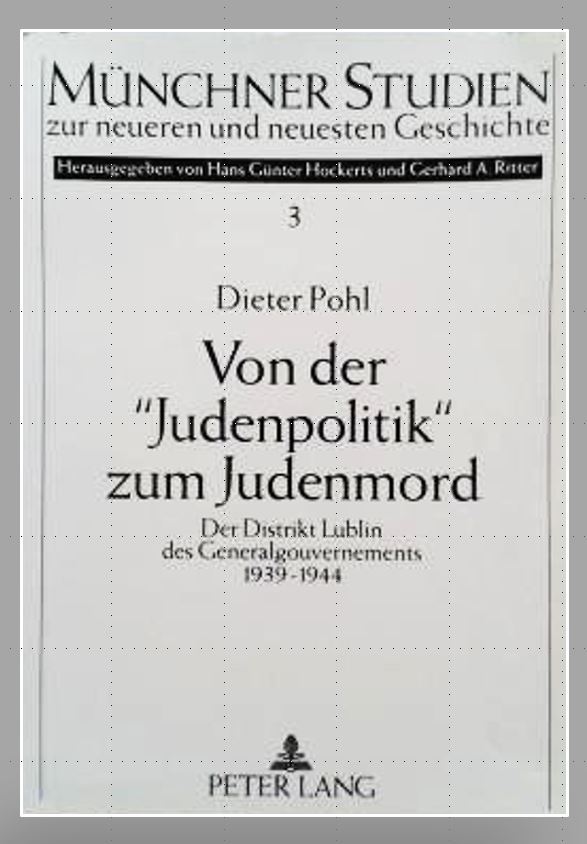 Perhaps the most important one was a small book from 1978 about the Nazi death camps on the territory of occupied Poland. [1] It was issued in quite a large print run by a popular German publishing house. It is a compilation of investigations that were conducted by Adalbert Rückerl, one of the main German prosecutors of Nazi war crimes. I was very much affected by this book. Eventually, I was introduced to other studies on this topic, in particular with Gerald Reitlinger’s book The Final Solution, which was the first good, general history of the Holocaust. It was published in 1953. Then I became acquainted with the works of Raul Hilberg. In Germany, at this time, it was impossible to acquire Hilberg’s book because it was published in Chicago in 1961 in a very small print run. [2] Some libraries had this book, but it was complicated and even impossible to obtain it. The prestigious German publishing house Fischer issued this book in softcover in 1990 (much later, in my early years of study). Both books are very important to me. [3] They helped me form my vision of the history of the Holocaust from the perspective of German perpetrators. Of course, there was a large number of other books that influenced me. The great turning point in German collective consciousness and memory of the Holocaust took place in 1979. That was when the American TV miniseries Holocaust “arrived“ in German homes. It caused a real shock in the country’s public sphere. Of course, from the perspective of a historian, a television series is not the best product. But it led to the emergence of a whole number of semi-popular and academic publications about the Holocaust. Thanks to this, German historiography today is mostly focused on the history of the Holocaust.
Perhaps the most important one was a small book from 1978 about the Nazi death camps on the territory of occupied Poland. [1] It was issued in quite a large print run by a popular German publishing house. It is a compilation of investigations that were conducted by Adalbert Rückerl, one of the main German prosecutors of Nazi war crimes. I was very much affected by this book. Eventually, I was introduced to other studies on this topic, in particular with Gerald Reitlinger’s book The Final Solution, which was the first good, general history of the Holocaust. It was published in 1953. Then I became acquainted with the works of Raul Hilberg. In Germany, at this time, it was impossible to acquire Hilberg’s book because it was published in Chicago in 1961 in a very small print run. [2] Some libraries had this book, but it was complicated and even impossible to obtain it. The prestigious German publishing house Fischer issued this book in softcover in 1990 (much later, in my early years of study). Both books are very important to me. [3] They helped me form my vision of the history of the Holocaust from the perspective of German perpetrators. Of course, there was a large number of other books that influenced me. The great turning point in German collective consciousness and memory of the Holocaust took place in 1979. That was when the American TV miniseries Holocaust “arrived“ in German homes. It caused a real shock in the country’s public sphere. Of course, from the perspective of a historian, a television series is not the best product. But it led to the emergence of a whole number of semi-popular and academic publications about the Holocaust. Thanks to this, German historiography today is mostly focused on the history of the Holocaust.
What place does the history of the Holocaust occupy in Austrian and German academia?
We must distinguish between the Austrian academic world and the German one. Whereas in Austria today there are about six universities that offer History, in Germany, there are some fifty to sixty. The general picture of German academia (especially in the humanities) is one of extraordinary diversity, pluralism, and democracy. As regards historical scholarship, in recent decades, this world has utterly changed. I did my studies in the 1980s. At the time, teaching was focused on German national history. The dominant emphasis was on a “pure” narrative devoted to German history of the last five or six centuries. Then this situation changed fundamentally, and today we are studying history from significantly broader perspectives: social history, cultural history, gender history, the history of emotions. There is also a post-national approach to the study of history. The national perspective was thus transformed into one of many other approaches to history writing. If you compare the German and Austrian views of history, the latter is focused somewhat more on cultural questions. In contrast to the U.S. or other countries, the history of the Holocaust in German universities was not turned into a separate subject. It is integrated into the general structure of History Studies. There is a single exception: Touro College Berlin (a small, private, American college), where the history of the Holocaust is studied as a separate subject. However, this situation is not very typical of Germany and Austria. There have been lengthy discussions of why Germans do not have institutionalized studies of the Holocaust in universities. This situation has its pluses and minuses. Among the minuses, I would mention the large number of students who have never encountered Holocaust Studies. On the other hand, in Germany, there are considerably more opportunities for contextualization. If you want to research the history of the Holocaust, you are obliged to learn the context: the history of the Second World War, the fundamental nature of dictatorship, the history of the Nazi occupation of various countries in Europe, and, of course, the history of the Jews. By comparison, Holocaust Studies in the U.S. and, to a certain extent, in Israel, are much more isolated. This is my personal impression. Students there are focused exclusively on the events of the Holocaust and its various aspects. If, for example, you ask them how the war was unfolding in 1942, they might not know anything about this. I believe that this creates a serious problem, inasmuch as the Holocaust is removed from the broader context.
“In Germany there is a tradition of studying the history of the Holocaust from the perspective of the perpetrators”
What trends in the development of modern world historiography of the Holocaust do you consider the most important?
In Germany, there is a tradition of studying the history of the Holocaust from the perspective of the perpetrators. It envisages research on the history of Nazi organizations and the policies of the Reich. For a long time, our historiography was concentrated on German Jews. Starting in the 1980s, the history of the Holocaust began to be reinterpreted in Germany. Since then, the research focus has been on questions related to the study of the activities of the Nazi elites and the fate of the German Jews. This perspective changed somewhat only after the fall of the Iron Curtain. First of all, the focus shifted to Eastern Europe, which had suffered the most because of the Holocaust. The second change, which took place in the 1990s–2000s, saw attention shifting to the Jewish perspective of the events of that period. There are now quite a few historians in our country who are studying Jewish life during the occupation, their survival strategies, etc. The latest trend (which is characteristic not just of German historiography) lies in researching the surrounding societies. Of course, German society is in first place here, but today the research subject has expanded to all societies that were under German occupation, as well as the societies in those states that were Nazi allies (Hungary, Romania, etc.). Thus, a shift has taken place in the direction of researching the events of the Holocaust in the “perpetrators/victims/bystanders” triangle.
Geographic boundaries and the research subject have also expanded (gender history of the Holocaust has appeared, as well as the history of children and other trends). The latest questions on which researchers have focused their attention include the problem of forced labor and looting. Serious debates have taken place around the restitution of Jewish property (this concerns not just Germany but many other European countries as well). This has added new aspects to the historiography of the Holocaust. The historiography of the Holocaust in Germany is thus extraordinarily well developed. However, it is somewhat strangely institutionalized. We have only a few institutions that deal with research on the history of the Holocaust. One of them is the Fritz Bauer Institute in Frankfurt. Another one is the Center for Research on Antisemitism in Berlin and the Center for Holocaust Studies in Munich. The third is located in Austria: the Vienna Wiesenthal Institute for Holocaust Studies. This is a very insignificant number in comparison with Israel or the U.S., where a considerably larger number of research centers dedicated to the history of the Holocaust has been created. However, the results of the expansion of the historiography of the Holocaust in Germany are significantly better than those in both of those countries. In Germany, the majority of research on the history of the Holocaust is being done at the dissertation-writing stage.
Since the 1990s, studies devoted to the Holocaust have increasingly focused on so-called “bystanders.” What important methodological changes took place in assessments of the role of “bystanders” during the genocide?
The term “bystander” was introduced by Raul Hilberg in 1993 in his book Perpetrators Victims Bystanders: Jewish Catastrophe 1933–1945. The big problem with this category is that it is too broad. Anyone who is either a victim or a perpetrator is a bystander. And if you proceed from Hilberg’s books, then there is an immense number of various types of bystanders. That number includes the United States, Polish peasants, the pope, etc. Several years ago, a big conference devoted to the bystander concept took place in Amsterdam. [4] The participants agreed that this term is not very helpful because it is too general. If we look at the etymology of the word “bystander,” it denotes a person that was truly near an area where the Holocaust was taking place. In this context, it is difficult to view the U.S. or Japan as bystanders. Another problem is that significant numbers of groups that had been previously regarded as bystanders were, in fact, co-participants in the Holocaust. For example, German christian society was viewed as a bystander. But today, we know that a significant proportion of German society took part in robbing Jewish property. There is an excellent study that examines these processes in Hamburg. It analyzes what happened to Jewish property after the deportation of the Jews (victims’ furniture, etc.). A broad spectrum of possibilities for acquiring property cheaply opened up for Germans (today, for example, some items are still on eBay). We know that over a hundred thousand residents of Hamburg availed themselves of this opportunity. There was also a rather widespread phenomenon of people denouncing Jews in order to gain material benefits. It is also useful to distinguish German society, which was viewed as an observer during the genocide, from occupied societies (Ukraine, for example), which were very different in terms of prerequisites, the structure of organized power, and possibilities and freedom of action. This is another reason why they are difficult to combine within the framework of a single, generalizing category. I prefer the distinction between such discrete groups as German society, occupied societies, foreign states, partisan movements, the church, etc. From the analytical point of view, this is much more helpful.
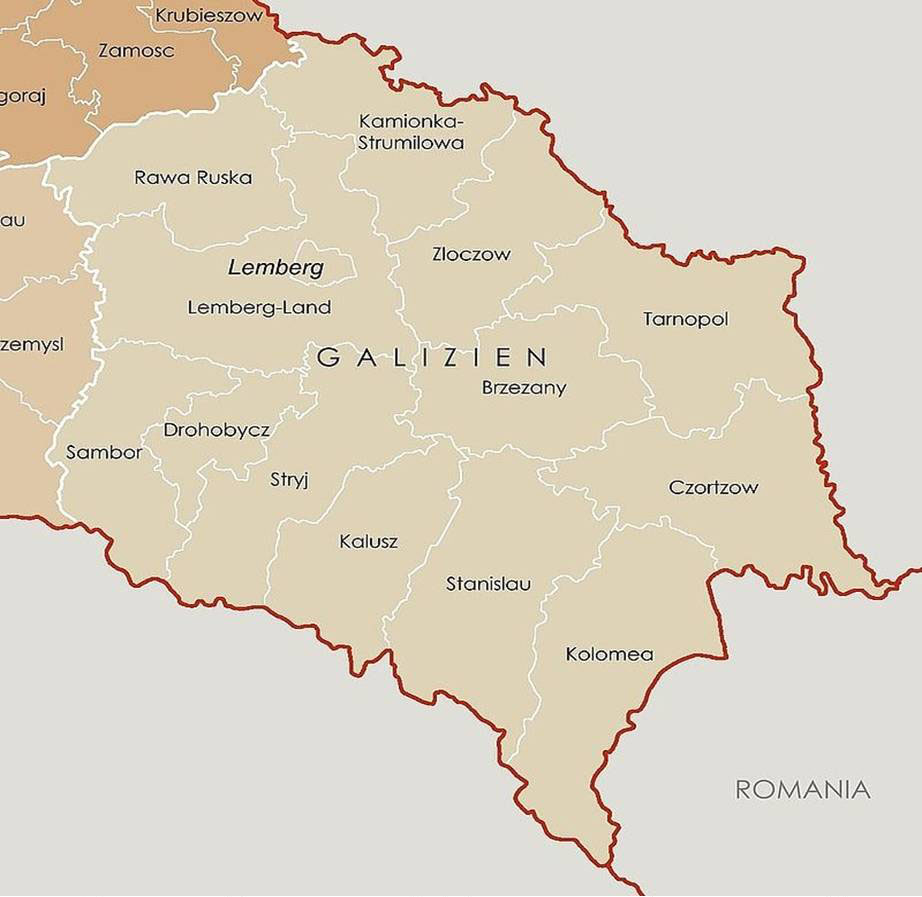
How is the role of economic factors in the implementation of the Holocaust defined today?
Previously, there was the Marxist approach, which viewed the Holocaust in the context of capitalism. From today’s perspective, we understand that the cause of the Holocaust was not the economy. People were killed because they were Jews. The German leadership regarded them as a separate race. The economy played an extraordinarily important role but in a very different context. First of all, it is important to know what role economic factors played in the Holocaust from the perspective of the Nazi leadership. When the November 1938 Pogrom [Kristallnacht—Trans.] took place, Jews were obliged to pay a fine of one billion Reichsmarks. This was connected to the circumstance that in 1938 the German state was on the verge of bankruptcy. Germany had a big military industry, but its production could not be invested in further economic development. So in 1938, German finances were vanishing, and this is one of the main reasons why Jews were fined one billion after the November Pogrom. Economic motivation also spurred the Nazi leadership into carrying out the Anschluss of Austria. The issue was not so much the integration of the “southern Germans” into a single state as about Austrian state finances. The further exploitation of the Jews did not play a significant economic role. Estimates reveal that Jewish property looted in Eastern Europe comprised only five percent of the expenses for the occupation (food and lodgings for German troops, salaries of members of the German occupying administration, etc.). Of course, it should be kept in mind that Eastern European Jews were not very wealthy. In Western Europe, Jews owned somewhat larger amounts of capital. But that was not what motivated the Nazi leadership to persecute and kill them. However, if we look at lower-ranking criminals and society as a whole, two important issues come to light. First, there was a belief among local communities that Jews were fabulously wealthy. And even where Jews from shtetls who were extremely poor are concerned, there was a stereotype that they were hiding their treasures somewhere. This was one of the reasons why, after the deportation of the Jews, a large number of people headed to the ghetto in search of “Jewish gold”. Thus, two factors were important for local residents: ideology and economic motivation. The latter was precisely the reason behind the participation of local residents in the hunt for Jews. Economic motives were actively exploited by the occupying regime in order to encourage people to expose Jews: recompense for denunciations was offered. For people who were living in poverty-stricken conditions, this was a key motive behind their decision to denounce Jews. Thus, it is necessary to distinguish economic motivation on the level of German Nazi leaders from societies. The economic conditionality of the attitude to the Jews on the part of members of surrounding societies was a significantly more widespread phenomenon. But this is an immanent feature of the majority of societies and epochs. Such motives can also be seen in the study of pogroms during the Middle Ages. The belief that Jews were fabulously wealthy is a typical anti-Jewish stereotype.
Economic motives played an important role at various stages of the Holocaust. For example, the historian Christian Gerlach has shown that the Nazi regime on Polish territory was supposed to supply the Reich with an immense quantity of food. This significantly accelerated the rate at which Jews were murdered, inasmuch as their destruction was regarded by local administrations in some areas as a chance to preserve a larger quantity of food for the Reich. But this only speeded up the killings; however, this was not the main reason.
When German SS groups entered the USSR in June 1941, they killed only adult Jewish males during the first six weeks. These men were considered the “most dangerous Bolsheviks.” But these actions meant that huge numbers of women and children were losing their breadwinners and left to fend for themselves. At that point, the German administration would have had to ensure that they be supplied with food. Naturally, the representatives of the German administration had no desire to do this. Thus, a conclusion suggested itself: they had to be killed. In the context of such structural factors and the “rationalization” of ideological motives, the economic factor was very important for the Holocaust. This kind of rationalization was common among many organizations; it was claimed that the killing of the Jews was necessary. The question of economic motivation is thus particularly complex. We cannot claim that Jews were killed only because the Germans wanted to seize their property.
How are structural and institutional factors in the organization of the Holocaust assessed in current historiography?
Discussions of whether the Holocaust was a “state-sponsored” genocide or a crime for which the entire society is responsible are still ongoing. To me, the arguments in favor of state-organized genocide are quite obvious. This is clearly evident if you compare the Holocaust to other genocides, in which the involvement of society was significantly greater. For example, there was much greater public involvement in the Maoist mass killings. Members of society were called upon to denounce their neighbors and even to kill them. This is what happened when Mao came to power as a result of the revolution of 1949 (unfortunately, these facts are little known in contemporary historiography; the mass killings during the period of the Cultural Revolution of the 1960s are much better known). The organization of mass murder in Nazi Germany and the Stalinist USSR occurred in a completely different way. In both cases, the state played an extraordinarily important role, as it outpaced society in forming an official ideology to justify the murders. Of course, antisemitism was not a new phenomenon, but Nazi Germany included it in the official agenda of state policies. It gave it an organized character. This organization was extremely important for the integration of diverse social groups into the genocidal process. There are quite a few studies written about the behavior of rank-and-file criminals (for example, Christopher Browning’s book Ordinary Men). They describe absolutely ordinary men who, prior to the war, worked in trade and other civilian occupations. They were mobilized into the police, and within a few weeks, they arrived in Poland in order to kill Jews. It is difficult to conclude that this case is a demonstration of a social crime. This was the result of the implementation of a state plan to organize an act of genocide. An important role in this was played by the state-created framework of the “lawfulness of crime.” Every German knew that murder was against the law. When one was committed, it was severely punished. Only the state could abolish these legislative restrictions. The third characteristic of Nazism and Stalinism (as well as Maoism) was the presence of a charismatic leader. The criminals believed that they were carrying out the will of their charismatic leaders. These three aspects of mass murder may be explained only within an organized, institutional context. One interesting feature of the German state during the Nazi period was its transformation: the creation of new institutions along the lines of the SS, which was responsible for mass killings. The SS was the paramilitary wing of the Nazi Party; that is, it was a party organization. In 1941 the SS and the state police had already been merged into a mutually interwoven apparatus to take charge of the killings. This was a very important structural component in the organization of the genocide. If you analyze other genocides, for example, the murders of communists in Indonesia in 1965–1966, the militias, which was involved in the killings, was formed there in rural areas with a significantly dominant and self-organized local population. In many other cases of mass killings, we see the society mobilized to commit crimes and even self-organization within its ranks. In the case of Nazi Germany and the USSR, everything took place in a completely different way. Without analyzing the role of the state, you cannot explain how the organization of mass killings took place. After all, this is not about “pogroms” but about “state-sponsored mass murder that envisaged totality” (every Jew was supposed to be killed).
How would you assess the evolution of the historiography of the Holocaust in Ukraine today? What trends do you consider the most promising for Ukrainian researchers?
The historiography of the Holocaust in Ukraine is not very well developed. At the present time, there are practically no comprehensive studies of the Holocaust on the territory of Ukraine. There are some regional studies about the events of the Holocaust in Eastern Galicia, Volyn, and eastern Ukraine. To this day, there is not a single monograph on the Holocaust in Kyiv. Karel Berkhoff’s study of Ukrainian society during the occupation period is focused on Reichskommissariat Ukraine. But this is just the beginning stage of such studies. In Ukraine, there is a lack of studies devoted to the Nazi occupying regime and its regional features, studies of society during the occupation, studies of Ukrainian society’s attitude to the Holocaust, etc. At the same time, there are quite a few studies on the history of the Holocaust in occupied Ukraine (over a hundred, perhaps). However, studies of the fate of other victims of Nazism are only at the beginning. Today some work is being done on the fate of the Roma and the residents of psychiatric hospitals, but practically no one is studying the overall fate of Soviet prisoners of war who were killed on the territory of Ukraine. There were huge camps for Soviet POWs (some were Ukrainian, but there were significantly more Russians and members of other nationalities), hundreds of thousands of whom were killed on the territory of Ukraine. There are studies on some of these. It is very important to recreate this general picture of violence. The focus of research should be on society. It is eminently clear that we cannot call it “Ukrainian” because this would reflect an ethnically biased position. At issue above all is Ukrainian society: how it was involved in the events of the Holocaust, how did it react to it, what changes took place in it during the occupation, the regional characteristics of the occupation and the Holocaust, the role of the Organization of Ukrainian Nationalists in western Ukraine during this period, etc.
“The origins of the Holocaust should be sought outside the borders of Ukraine”
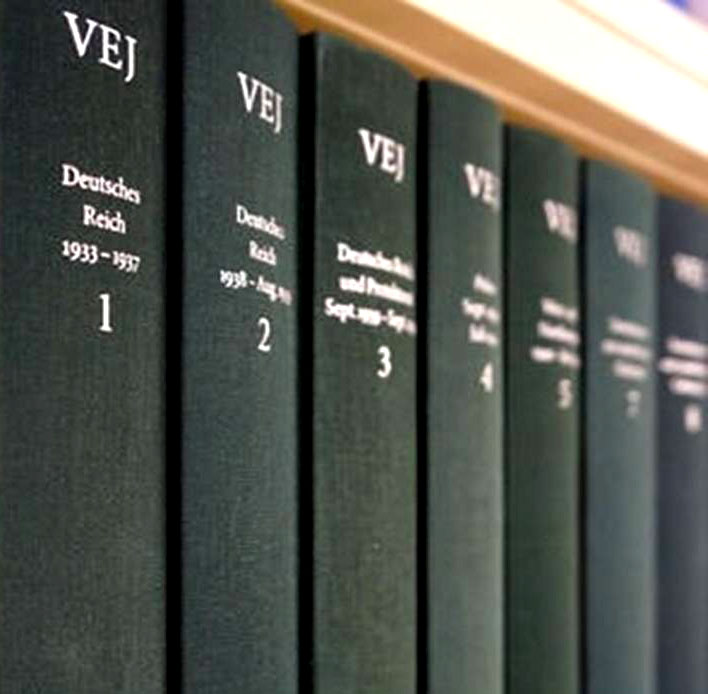
How do you view the prerequisites and origins of the Holocaust on the territory of Ukraine?
The first important prerequisite of the Holocaust in Ukraine is the formation and development of the Nazi policy of genocide. It is of external origin because the origins of the Holocaust should be sought outside the borders of Ukraine. The prerequisites that originated in Ukraine are the behavior of the local population during the Holocaust. In order to understand the foreign political prerequisites of the Holocaust, one should look at the events that were taking place in occupied Poland in 1939–1941. Of course, in the months of June and July 1941 in the occupied territories of the USSR, the Nazi regime first switched to the policy of systematic genocide. An important prerequisite of the behavior of the local population during the Holocaust in Soviet Ukraine was the experience of Stalinism. However, I don’t really agree with the notion that the Holodomor was an important part of the prehistory of the Holocaust. For example, in Belarus, there was no Holodomor, but Jews were killed there on the same scale as in Ukraine. No serious differences were observed. However, the Holodomor is interesting in that it is the experience of extreme violence on the part of the state. Furthermore, an antisemitic interpretation of the Holodomor already appears during the interwar period. This point of view remains relatively widespread to this day. In Ukrainian Wikipedia, I read an article entitled “The History of the Jews of Ukraine.” It states that Jews share the blame for the Holodomor. Personal responsibility lies in particular on such Jewish heads of the NKVD or Lazar Kaganovich. Of course, that is a fact, but Jews also died as a result of the Holodomor. That is why this is quite a strange interpretation. Be that as it may, the Holodomor became part of the Ukrainian experience of mass violence. However, no less important is the Great Terror of 1937–1938, which atomized Ukrainian society. However, it is significant that the strongest appearance of antisemitism prior to the war was concentrated outside the borders of the USSR—in western Ukraine. Studies on Carpatho-Ukraine show that the level of antisemitism in this part of Ukraine was comparatively high in 1938 (when the Hungarians occupied this territory; after 1941, it declined). This is a rather interesting trend. In 1941 the highest level of antisemitism was undoubtedly in Eastern Galicia, and for the Jews, it became a definite trap. On the one hand, most of them did not manage to be evacuated because of the rapid advance of the German army and the proximity to the border. On the other, the surrounding society here turned out to be more strongly marked by antisemitism than in central Ukraine. Furthermore, the Organization of Ukrainian Nationalists enjoyed considerable popularity on the territory of western Ukraine. Interestingly enough, in eastern Ukraine, the OUN was structured significantly more democratically than in western Ukraine. The problem with the OUN, in comparison with other fascist movements in Europe, lies in the fact that former democratic groups were also integrated into this organization (for example, the faction headed by Ivan Mitrynga, among them Borys Levytsky, who represented the left-wing of the nationalist movement). These local prerequisites are very important for comparative analysis. Its results allow us to conclude how strongly regional differences affected the fate of the Jews during the Holocaust.
Can we contextualize the Holocaust within the framework of national historiography?
I regard the writing of this history as an extremely important task. First of all, a huge Jewish community lived on the territory of Ukraine. Second, the OUN played a specific role in Ukraine (nationalism was also of great significance in the Baltic Republics.) The killings in Babyn Yar, Kamianets-Podilsky, and Odesa were particularly important events in the context of the implementation of the Holocaust. The highest number of killings during the Holocaust in Ukraine probably took place in 1942, but to this day, this has not been adequately researched. These killings were committed not by the Germans but by the Romanian occupation authorities. It is interesting that the shootings were carried out not by special killing squads (even though the Romanian government had such detachments) but by the 10th Romanian Infantry Division in Odesa. The Germans had offered their support during the commission of these killings, but the Romanians rejected it, assuring them that they would do everything with their own forces. This was one of the most horrific killings. Nearly ten percent of all victims of the Holocaust in Ukraine died during this “Romanian Holocaust.”
Professor Jan Grabowski recently stated that German historiography pays insufficient attention to the problem of collaboration. What is your position on the role of collaboration during the Holocaust?
I understand Professor Grabowski very well. He has become the focus of criticism and persecution by the Polish authorities. But his recent critique of German historiography of the Holocaust relies on somewhat distorted arguments. Starting in the 1990s, a number of studies about collaboration appeared in German historiography. Professor Grabowski works on the micro-level of history. He researches the Polish police and the behavior of other Poles during the Holocaust. During the occupation Poles, autonomously killed between 30,000 and 60,000 Jews. I would guess that this is roughly one to two percent of all Holocaust victims on the territory of Poland. However, it was the Nazi occupying regime that introduced the policy of genocide in occupied Poland. Still, Professor Grabowski says little about this general context, about the atmosphere that the Germans created in the lands of Poland. It was this very thing that prompted the brutalization of society, after which a considerable number of Poles became co-participants of the genocide. My second comment concerns the term “collaboration.” This is a political concept that is connected with national loyalty. A collaborator is one who, during a foreign occupation, betrays his national group. The term “collaboration” comes from France and refers to the cooperation between the Vichy regime and Nazi occupation authorities. In the case of France, this concept is of considerable scholarly value. But what does one do in the case of Ukraine? Should Ukrainians have remained loyal to Stalin? Loyalty to whom should the Ukrainians have betrayed during the Nazi occupation? This is a very problematic question. Finally, there were quite a few people who fought against the German occupation and at the same time killed Jews. In the case of the Polish police, it is obvious that a considerable number of policemen who were cooperating closely with the underground also killed Jews. Individual underground groups killed Jews on their own initiative. And this concerns not just Poland but also the Ukrainian Insurgent Army (UPA). Therefore, the concept of “collaboration” is very problematic. However, we use it to define cooperation with the occupation authorities during the implementation of the Holocaust.
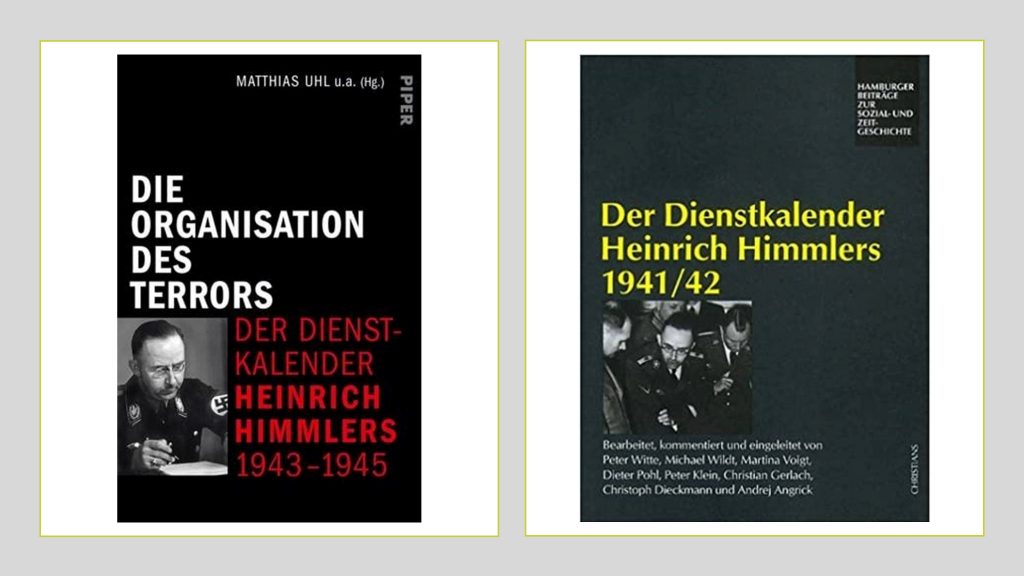
Quite a few Ukrainians cooperated with the Nazi regime during the implementation of the Holocaust. Most of them were members of the auxiliary police. The Germans could never have killed such a large number of Jews on their own. They did not even know the language or the local features that would have allowed them to identify Jews. This may not have been so complicated on the territory of western Ukraine, inasmuch as Jews lived there in compact, traditional communities and often had a distinctive appearance. However, it was much more complicated to identify Jews in Kyiv. The auxiliary police carried out a substantial amount of work to identify victims. Omer Bartov’s new book about Buchach eloquently demonstrates the vigor of the Ukrainian police in the process of killing Jews.
Members of local administrations (community elders, local mayors, local civil servants, etc.) also played an important role. The question of their role in the Holocaust remains insufficiently researched. Thus, in order to resolve the majority of infrastructure problems in the implementation of the Holocaust policy (for example, the registration of Jews; the search for the optimal sites for carrying out mass murder; the preparation and burial of mass graves; the identification of locations for ghettos), the Nazis turned to local administrations, comprised of local inhabitants. Tens of thousands of Ukrainians served in the auxiliary police units and local administrations. They cooperated with the Nazi regime in the process of the persecution and murder of the Jews. This is a fairly common phenomenon, intrinsic to the majority of the occupied territories of the USSR and Poland (with the exception of western Poland, where the Germans did not practice collaboration). Differences can be traced in the structure and organization of a local government. In Latvia, for example, representatives of the titular nation were allowed the creation of a central body that was subordinated to the occupation administration. Thus, a Latvian collaborationist government existed. Ukrainians also sought to form such a government, but the Germans refused. An important question is what motivated the employees of these local administrations to help kill Jews. In my opinion, most of them were not antisemites. There was an antisemitic milieu and discourse, but it is unlikely that this led to the majority’s being convinced that all Jews should be killed. This approach to the “Final Solution of the Jewish Question” has been used mostly within the German discourse.
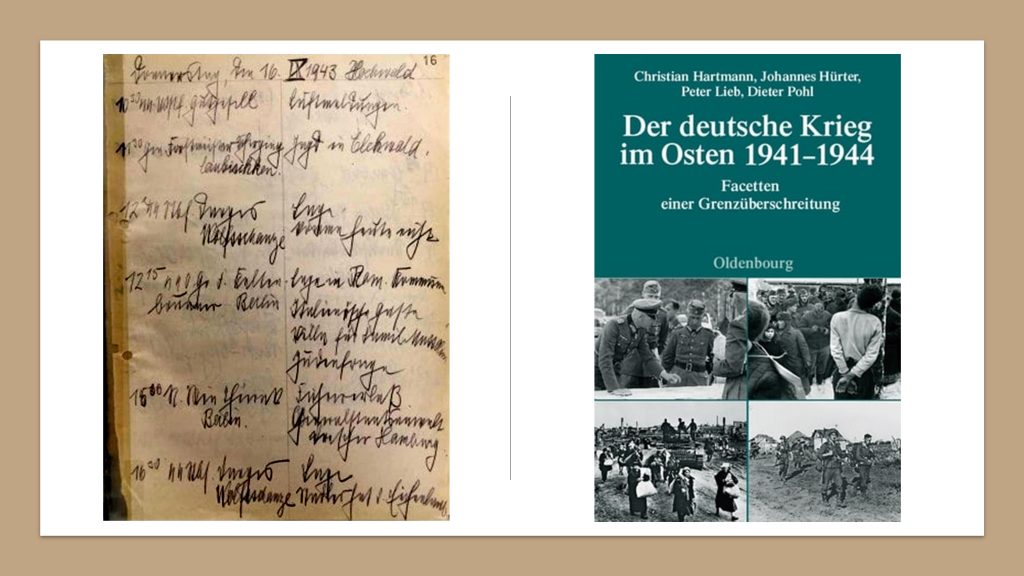
Thus, some members of Ukrainian society cooperated with the Nazi administration. They did this not only during the killings of Jews but also of people with psychiatric disorders (local medical personnel were recruited for this). After the war these were the very people who were most often punished for their participation in the Holocaust. As for the Germans, during the postwar period, approximately 30,000 to 35,000 murderers were prosecuted. For the purpose of comparison, 300,000 trials of collaborators took place in the USSR alone (roughly 50,000 of which were held in Ukraine). From the viewpoint of Ukrainian national thought, the Nazi authorities occupied and terrorized Ukraine. However, some people became co-participants in these crimes. Today one can speak openly about this, especially in a democratic environment. The situation in Russia, Latvia, and other zones of occupation was similar. But today, there is a fairly popular tendency to distinguish between what the nation experienced during the occupation and what the Jews experienced (these events are often examined separately within the framework of national narratives). For example, Riga has a Museum of the Occupation of Latvia, but it devotes very little attention to the Holocaust. In order to learn about it, you have to visit the Jews in Latvia Museum. Looking at the Holocaust as something that exists outside the narrative of national history is quite a typical trend in post-communist states. However, the modern democratic narrative of national history should demonstrate all aspects of the past.
You published a review of the American historian Timothy Snyder’s book Black Earth. Could you outline your main critical comments on this work?
Timothy Snyder sought to create a new history of the causes and origins of the Holocaust. His main thesis is that both Hitler and Stalin destroyed the Eastern European states. Without their own states, the societies in this region became defenseless, and this is one of the reasons why so many Jews were killed. Of course, there is some truth to these arguments. However, there are quite a few other causes of the Holocaust. Hence, Black Earth contains many interpretations that are not entirely correct. Snyder’s previous book, Bloodlands, was quite a good historical survey of mass violence in Central–Eastern Europe. It’s not a bad book for a wider audience, but it contains a number of problems if you analyze it from a scholarly standpoint. The first problem is periodization. If we analyze Soviet violence, then research must begin with 1918 (not the 1930s). The second concerns the definition of the term “bloodlands,” where the Soviet and Nazi repressive regimes existed in different periods. However, in the Polish territories where most of the death camps were created, the Soviet regime did not appear at least until the final stage of the Second World War. My third comment on this book relates to the inadequate consideration of the role of society in unfolding the dynamics of totalitarian violence. Ukrainians, Belarusians, and other groups appear in this book only as victims. Snyder is now writing a book about the current political situation. He is, without doubt, an extraordinarily intelligent person and an excellent writer.
What gender aspects of the course of the Holocaust on the territory of Ukraine would you identify?
To this day, the history of gender and the Holocaust remains inadequately studied. There are quite a few micro-studies, but there is a great lack of general conceptualization. The first gender aspect that I would identify is the fact that nearly ninety-nine percent of criminals were men. Some female criminals were police secretaries. However, this context is more important for the history of the Holocaust in Germany, where women also figured among concentration camp guards. No less important in Nazi Germany was the participation of women in killing people with psychiatric disorders (often in the capacity of nurses). The second important gender aspect of the Holocaust is the fate of Jewish women. There was a certain antisemitic perception of Jewish women: they were considered to be very dangerous. It is clear that women were among the first victims of the mass killings. However, during the short-lived, early period, the Germans killed mostly military-age males. In late 1941 they halted this process, realizing that there was a growing labor shortage. Thus, the Germans allowed males to live for some time. The killings spread to women and children. Women were considered a suitable workforce for the textile industry, but this sector of the economy was not a priority one. However, it is worth remembering that Jews were killed because they were Jews. The question of how the antisemitic image of a Jewish woman influenced the behavior of the criminals is still under-researched. Finally, an important gender aspect of the history of the Holocaust is sexual violence. However, such cases are very difficult to find in historical sources. Research in this direction began only in the last decade. It concerns not only sexual violence committed against Jewish women but also sexual relations between Germans and local women, which were often characterized by violence. I think that this is a very important aspect of the history of the Holocaust, and as of today, it is at the preliminary stage of study. A budding trend is the study of the fate of homosexuals. This trend is quite politicized, inasmuch as it is connected with current cultural movements.
“One key problem with the commemoration of the OUN and the UPA is that these organizations did not follow democratic traditions and did not strive to create a democratic Ukraine”

How would you characterize contemporary trends of the culture of remembrance of Holocaust victims on the territory of Eastern and East-Central Europe?
The first trend lies in the gradual integration of the history of the Holocaust into national memories. If we look at the EU, the Holocaust is becoming increasingly central to the memory of the Second World War. In Ukraine, the situation is somewhat different. During the Soviet period, the memory of the Holocaust was suppressed (with some exceptions during the early postwar period, 1944–1946). The memory of the Holocaust began to return to the public discourse only during perestroika. A number of symbolic acts, including the installation of a menorah in Babyn Yar in 1991, took place in Ukraine. But most of them had a local character. Ukraine has been independent for thirty years, but to this day, there is no central memorial in Babyn Yar. Fierce discussions on this topic continue today. I was a member of the Scholarly Council of the Babyn Yar Holocaust Memorial Center. Today its activities have become very problematic, not just in terms of sources of financing but also the content and directions of work. For that reason, I left the council in April 2020. But if we look at the concept of the memorialization of Babyn Yar that was developed by the National Academy of Sciences of Ukraine, it is more nationalistically oriented and features only a few accents on the history of the Holocaust. Therefore, this too is an unacceptable concept of memorialization.

Omer Bartov noted aptly that today rather strange commemorative practices are taking place in the areas where most of the victims resided and the places where they were murdered en masse. They concern the nationalistic movement of the OUN and the UPA. In some cases, monuments to the UPA are being installed (for example, in Drohobych) on the sites of former Jewish ghettos. As regards the general culture of remembrance of Holocaust victims (school textbooks, official commemorations, etc.), I think it is quite developed in Ukraine. But it lacks stable structures. The city of Dnipro has a huge Memory of The Jewish People and The Holocaust In Ukraine Museum. But such museums should be created at the very least in Kyiv and Lviv. More memorials should be built in western Ukraine. Of course, Germany is obliged to provide material aid in realizing such projects.
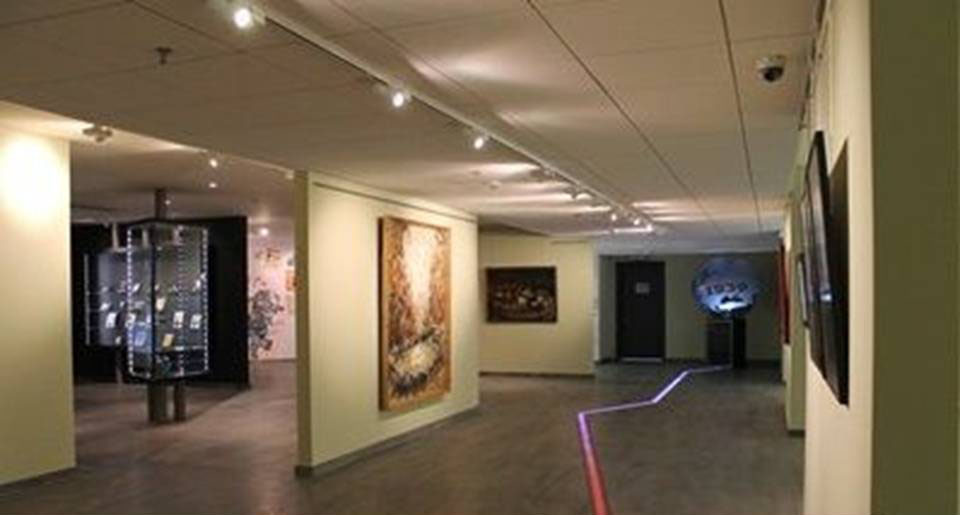
What, in your opinion, should Ukraine do in order to achieve reconciliation around the tragic pages of the Second World War?
I am not convinced that reconciliation will be possible in the next few years. In my opinion, this will happen when the memory of the Second World War in Ukraine no longer plays an important role. This will happen thanks to the change of generations. Second, in the last few years, nationalistic trends have been observed in the Ukrainian public discourse, which has led to attention being focused on the OUN and the UPA and the passage of the rather strange Law of Ukraine “About the Legal Status and Honoring of the Memory of Fighters for Ukraine’s Independence in the XX Century” (which I regard as unsuitable for the contemporary realities of remembrance). People should also be clearly aware that the OUN was at the very least a semi-fascist organization, that the UPA killed tens of thousands of Poles and many Jews. There is quite a lot of research on this abroad and in Ukraine. But the key problem with the commemoration of the OUN and the UPA is that these organizations did not follow democratic traditions and did not seek to create a democratic Ukraine. If you look for symbols connected with the democratic tradition, you have to go back to 1918, and not to 1941. This is important for the formation of a democratic culture and awareness in Ukrainian society. Commemoration policies with a focus on nationalistic organizations and movements will not foster this. The naming of streets in honor of Bandera in Lviv or Kyiv is quite strange to us, but I am certain that Ukraine will build a democratic political culture. It took the Germans dozens of years to come to grips with their complex past. This is a long process that should stem from domestic, social impulses, not from foreign influences.
Interviewed by Petro Dolhanov
The photographs accompanying the article are from Dieter Pohl’s private archive and open sources.
 Dieter Pohl is Professor of Contemporary History at the University of Klagenfurt (Austria). He was the spokesman of the International Advisory Board of the Vienna Wiesenthal Institute for Holocaust Studies and member of the Executive Council of the European Holocaust Research Infrastructure (2009–2019). Today he is the spokesman of the Scholarly Advisory Board of the German War Graves Commission (Volksbund deutscher Kriegsgräberfürsorge). Professor Pohl has extensive experience in coordinating and leading national and European scholarly research projects. He headed the German–Israeli project “Database of Trials of Nazi Crimes in Germany” (1999–2003 ) and the research project “The SS in Germany Society” (2006–2010). His scholarly activities are concentrated on European and global history, 1930s–1950s, with a focus on the Nazi period; the German occupation and Nazi war crimes; the postwar history of East Germany; the history of the Soviet Union; and Ukraine and Poland in the twentieth century. He is the author of many studies, including Nationalsozialistische Judenverfolgung in Ostgalizien 1941–1944 (1996); Holocaust. Die Ursachen—Geschehen—die Folgen (2000); Justiz in Brandenburg 1945–1955: Gleichschaltung und Anpassung (2001); and Verfolgung und Massenmord in der NS-Zeit (2003). He is the co-author with Frank Bajohr of Der Holocaust als offenes Geheimnis: Die Deutschen, das NS-Regime und die Alliierten (2006); and Die Herrschaft der Wehrmacht: Deutsche Militärbesatzung und einheimische Bevölkerung in der Sowjetunion 1941–1944 (2008). His other co-authored publications include: Der Dienstkalender Heinrich Himmlers 1941/42 (1999); Zwangsarbeit in Hitlers Europa (2013); A New Nationalist Europe Under Hitler: Concepts of Europe and Transnational Networks within the National Socialist Sphere of Influence (2019); Right-Wing Politics and the Rise of Antisemitism in Europe 1935–1941 (2019); and Die Organisation des Terrors: Der Dienstkalender Heinrich Himmlers 1943–1945 (2020). He is the co-editor of the 16-volume document series Die Verfolgung und Ermordung der europäischen Juden durch das nationalsozialistische Deutschland 1933–1945 (2007–2021), which has been published in English, in cooperation with Yad Vashem, under the series title The Persecution and Murder of the European Jews by Nazi Germany, 1933–1945.
Dieter Pohl is Professor of Contemporary History at the University of Klagenfurt (Austria). He was the spokesman of the International Advisory Board of the Vienna Wiesenthal Institute for Holocaust Studies and member of the Executive Council of the European Holocaust Research Infrastructure (2009–2019). Today he is the spokesman of the Scholarly Advisory Board of the German War Graves Commission (Volksbund deutscher Kriegsgräberfürsorge). Professor Pohl has extensive experience in coordinating and leading national and European scholarly research projects. He headed the German–Israeli project “Database of Trials of Nazi Crimes in Germany” (1999–2003 ) and the research project “The SS in Germany Society” (2006–2010). His scholarly activities are concentrated on European and global history, 1930s–1950s, with a focus on the Nazi period; the German occupation and Nazi war crimes; the postwar history of East Germany; the history of the Soviet Union; and Ukraine and Poland in the twentieth century. He is the author of many studies, including Nationalsozialistische Judenverfolgung in Ostgalizien 1941–1944 (1996); Holocaust. Die Ursachen—Geschehen—die Folgen (2000); Justiz in Brandenburg 1945–1955: Gleichschaltung und Anpassung (2001); and Verfolgung und Massenmord in der NS-Zeit (2003). He is the co-author with Frank Bajohr of Der Holocaust als offenes Geheimnis: Die Deutschen, das NS-Regime und die Alliierten (2006); and Die Herrschaft der Wehrmacht: Deutsche Militärbesatzung und einheimische Bevölkerung in der Sowjetunion 1941–1944 (2008). His other co-authored publications include: Der Dienstkalender Heinrich Himmlers 1941/42 (1999); Zwangsarbeit in Hitlers Europa (2013); A New Nationalist Europe Under Hitler: Concepts of Europe and Transnational Networks within the National Socialist Sphere of Influence (2019); Right-Wing Politics and the Rise of Antisemitism in Europe 1935–1941 (2019); and Die Organisation des Terrors: Der Dienstkalender Heinrich Himmlers 1943–1945 (2020). He is the co-editor of the 16-volume document series Die Verfolgung und Ermordung der europäischen Juden durch das nationalsozialistische Deutschland 1933–1945 (2007–2021), which has been published in English, in cooperation with Yad Vashem, under the series title The Persecution and Murder of the European Jews by Nazi Germany, 1933–1945.
[2] The first edition of the book The Destruction of the European Jews.
[3] Raul Hilberg’s second important study, Perpetrators Victims Bystanders: Jewish Catastrophe 1933–1945.
[4] The conference “Probing the Limits of Categorization: The ‘Bystander’ in Holocaust History,” held on 24–26 September 2015. The conference proceedings were published as a book under the same title.
The accuracy of the facts and quotations cited in this article is the sole responsibility of the authors of the texts.
This project is supported by the Canadian charitable non-profit organization Ukrainian Jewish Encounter (UJE).
Originally appeared in Ukrainian @Ukraina Moderna
Translated from the Ukrainian by Marta D. Olynyk.
Edited by Peter Bejger.
NOTE: UJE does not necessarily endorse opinions expressed in articles and other materials published on its website and social media pages. Such materials are posted to promote discussion related to Ukrainian-Jewish interactions and relations. The website and social media pages will be places of information that reflect varied viewpoints.







